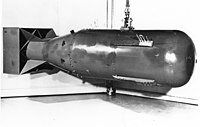
Photo from wikipedia
Abstract Differences in aerosol optical properties and associated radiative effects at ultraviolet (UV), visible (VIS), near-infrared (NIR), and shortwave (SW) spectra during haze periods between winter and summer of 2014… Click to show full abstract
Abstract Differences in aerosol optical properties and associated radiative effects at ultraviolet (UV), visible (VIS), near-infrared (NIR), and shortwave (SW) spectra during haze periods between winter and summer of 2014 in Wuhan were compared in this study. With the development of haze, the average aerosol optical depth increased from 0.371 to 0.769 in winter and from 0.602 to 1.163 in summer. A positive correlation was found between absorbing aerosol optical depth and black carbon, only in winter. The mean fine mode effective radius of aerosols increased from 0.128 μm to 0.166 μm in winter and from 0.179 μm to 0.229 μm in summer, due to hygroscopic growth under high humidity conditions during haze periods. The fine mode particles were more dominant in summer than in winter. The single scattering albedo (SSA) increased significantly in both seasons as a result of the emergence of numerous non-absorbent aerosols when haze occurred. The aerosol radiative effect (ARE) increased from −73.46 W/m2 to −115.38 W/m2 (−96.01 W/m2 to −135.67 W/m2) at the earth's surface, and from −15.09 W/m2 to −32.91 W/m2 (−20.49 W/m2 to −49.13 W/m2) at the top of the atmosphere because of the change from clear air conditions to haze periods in winter (summer). Unusual increases in aerosol radiative effect efficiency (AREE) from −40.78 W/m2 to −43.57 W/m2 and AREE fraction of UV in SW spectrum from 1.9% to 3.3% were found at the top of atmosphere in winter. This exception was probably due to dust aerosols with iron components, which had a strong UV absorption ability. The AREE dependence showed a high dependence on particle size in winter but a greater dependence on the SSA in summer. Back trajectory analysis with active fire areas from Moderate Resolution Imaging Spectroradiometer indicated that the black carbon originated from the North in summer, while active fires in winter were rare.
Journal Title: Atmospheric Environment
Year Published: 2019
Link to full text (if available)
Share on Social Media: Sign Up to like & get
recommendations!